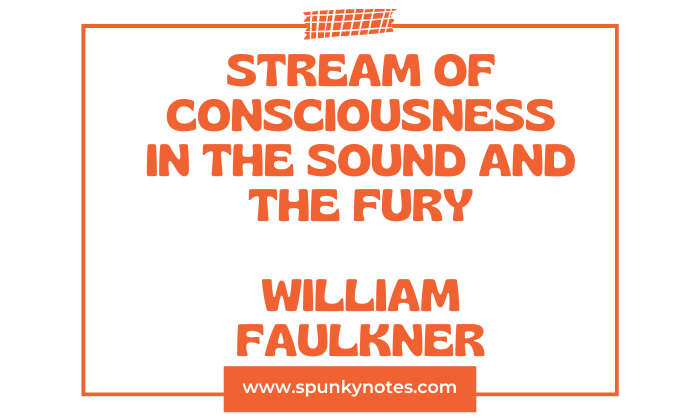
Q. How does the stream of consciousness in The Sound and the Fury show characters’ inner turmoil and fragmented perspectives?
Q. Write a note on the narrative technique used in William Faulkner’s novel The Sound and the Fury.
Introduction
The stream of consciousness is a narrative mode that attempts to depict the thoughts and feelings passing through a character’s mind. Pioneered by authors such as James Joyce, Virginia Woolf, and William Faulkner, it has since become a cornerstone of modernist and postmodernist writing. This technique immerses the reader in a character’s internal monologue.
Depicting the Character’s Inner World
Stream of consciousness gives us a direct line to a character’s inner world, often bypassing the filters of self-censorship or societal norms. We can hear their thoughts and feelings in real-time, accurately and unedited.
The raw and unfiltered nature of the stream of consciousness offers us an intimate understanding of the character. It would not be possible through dialogue or conventional third-person narration.
Benjy’s Perception: An Unhindered Emotionality
Benjy Compson, the narrator of the first section of “The Sound and The Fury,” presents a unique narrative voice. His mental disability distances his thought process from traditional linear reasoning, giving us an unconventional yet compelling perspective.
Through his stream of consciousness, we see the world as a tapestry of sensory experiences and emotional responses, untethered by the usual constructs of time and logic.
An unfiltered emotional rawness characterizes Benjy’s narrative. His sensory impressions intimately link with his thoughts and feelings. The sensations of smell, sound, and touch are prominent triggers for his memories. It transports him seamlessly through time and space.
For example, Benjy associates his sister Caddy with the smell of trees; he says,
Caddy smelled like trees.
What is most striking about Benjy’s narrative is its disregard for linear time. Instead, Benjy experiences the past and the present as one continuous flow. This is evident when the golfers yell, “Caddie,” which triggers memories of his sister.
Even though these memories are from different points in time, they occur in the immediate present for Benjy. At first, this nonlinear perception of time may confuse the reader. However, it ultimately opens up an intriguing exploration of the fluidity of memory and the subjective nature of time.
Moreover, Benjy’s narrative voice highlights his relationships with other characters, especially Caddy. His memories of Caddy are filled with warmth and affection, highlighting their close bond. Caddy’s departure leaves a profound void in Benjy’s life, a loss he communicates through his persistent mourning and emotional distress.
His section, thus, allows us to understand the emotional depth of his character and the significance of his relationship with Caddy.
Exploration of Fragmented Memory and Subjective Perception
Faulkner’s technique also allows a profound exploration of memory and perception. Benjy’s perspective is a vivid testament to this. His mental disability results in a fragmented consciousness that collapses past and present into a single, sensory-based perception.
William Faulkner uses this to investigate the nonlinear nature of memory and how sensory stimuli can trigger recollections, such as when Benjy associates the smell of trees with his sister Caddy. This perspective challenges conventional narrative structures, introducing readers to fluid, subjective time.
The individual streams of consciousness also illuminate the impact of personal experiences on shaping identity. The Compson brothers in The Sound and The Fury bear profound scars from their familial experiences, especially their connections with their sister, Caddy.
Benjy’s sensory-driven narrative illustrates his dependent relationship with Caddy. Quentin’s guilt-ridden thoughts reveal his complex love and resentment for Caddy, and Jason’s cynical musings underscore his embittered relationship with her.
These experiences significantly shape their identities, emphasizing the role of personal history in constructing individual selfhood.
Quentin’s Section: Time and Obsession
The second section of “The Sound and The Fury” is narrated by Quentin, the eldest Compson brother. He characterizes his stream of consciousness with a deep obsession with time and his sister, Caddy’s lost virginity, a sin he equates with the downfall of the family’s honor.
One of the most notable symbols of Quentin’s obsession with time is his broken watch. Despite the watch’s inability to tick, Quentin chooses to carry it. Even when the watch has stopped, the ticking he hears underlines his relentless torment, symbolizing his fixation on time.
Faulkner writes,
And I was not. When the shadow of the sash appeared on the curtains, it was between seven and eight o’clock, and then I was in time again.
This passage showcases Quentin’s internal struggle with time – his desire to stop it, his longing for the past, and his torment in the present.
His obsession with Caddy manifests in his constant replaying of the day when she revealed her virginity loss. He dwells on it, torments himself with it, and even fantasizes about a fabricated incestuous relationship, all in a desperate attempt to bear some of the guilt he believes Caddy should not have to bear alone.
Quentin’s stream of consciousness provides a tragic insight into a tortured mind consumed by obsessions with time and a misplaced sense of responsibility for his sister’s actions, leading him, eventually, to his destruction.
Jason’s Section: Materialism and Cruelty
Jason Compson, the third brother, narrates the third section of “The Sound and The Fury.” His stream of consciousness is characterized by bitterness, anger, and resentment. It starkly contrasts with his brothers’ narratives.
Unlike Benjy and Quentin, who are dominated by memories and psychological distress, Jason is rooted firmly in the present, and worldly concerns and schemes consume his consciousness.
Jason’s desire for control and financial gain primarily governs his worldview. This is particularly evident in his treatment of his niece, Miss Quentin.
He seizes the money that Caddy sends for her daughter and uses it for his means while blaming Miss Quentin for their financial hardship.
His cruel behavior, exploitation of his niece, and resentment towards his family, particularly Caddy, are unmasked through the direct and unfiltered access to his thoughts.
Thus, Jason’s consciousness gives us a deeper understanding of his character, which shows domination by bitterness, manipulation, and a disregard for familial bonds.
Conclusion
In William Faulkner’s “The Sound and The Fury,” the stream-of-consciousness technique offers a profound exploration of human consciousness, personality, and the complexity of human relationships. The distinct narrative voices of Benjy, Quentin, and Jason, alongside the perspective of Dilsey, create a multi-dimensional narrative that delves deep into the human psyche.
Benjy’s unhindered emotionality, Quentin’s tortured introspection, Jason’s bitter realism, and Dilsey’s compassionate stability offer diverse experiences.
The stream-of-consciousness technique offers a candid window into the Compson brothers’ deepest desires, fears, and contradictions. For instance, Quentin’s narrative is filled with his longing for the past and a time when his sister was innocent.
His fear of disgrace, guilt over Caddy’s downfall, and futile attempts to restore his family’s honor expose the contradictory nature of his consciousness, torn between societal norms and personal emotions.

